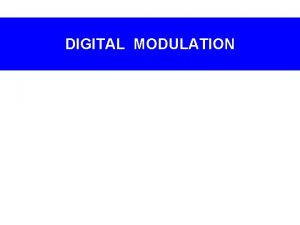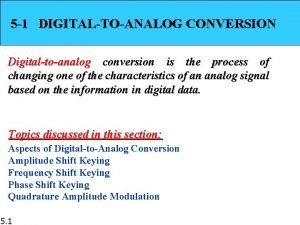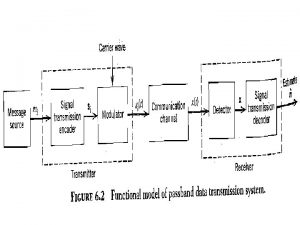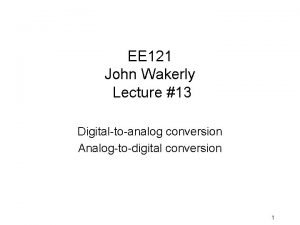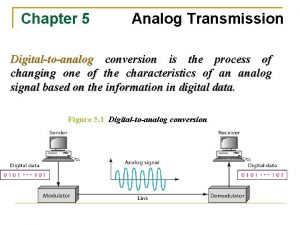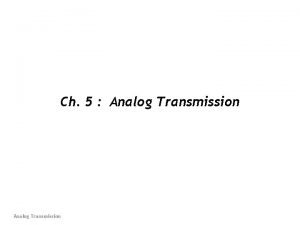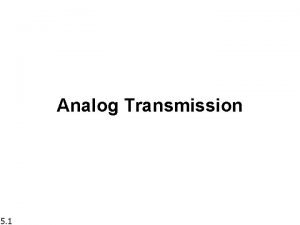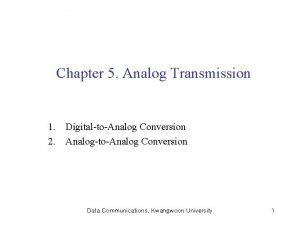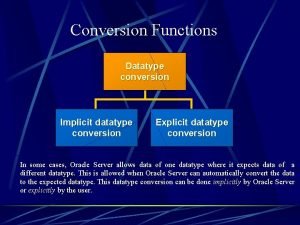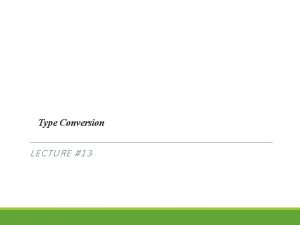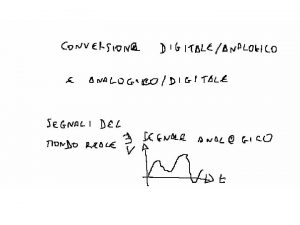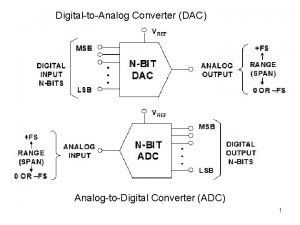DigitaltoAnalog Conversion Process of changing one of the

































- Slides: 33

Digital-to-Analog Conversion • Process of changing one of the characteristics of analog signal based on the information in digital data • A sine wave is defined by 3 characteristics: ü Amplitude ü Frequency ü Phase • By changing one of these characteristics, we can use it to represent a digital signal

Digital-to-Analog Conversion

Types of Digital to Analog Conversion

Aspects of Digital to Analog Conversion • Before we discuss specific methods of digital-to-analog modulation, two basic issues must be reviewed: ü Bit and Baud rates and ü The Carrier Signal

Aspects of Digital to Analog Conversion • In Analog Transmission of Digital Data, Baud Rate is less than or equal to the Bit Rate ü Data Element vs. Signal Element ü Data Rate vs. Signal Rate • Bandwidth Required ∝ Signal Rate (except FSK) • Carrier Signal

Aspects of Digital to Analog Conversion • Before we discuss specific methods of digital-to-analog modulation, two basic issues must be reviewed: ü Bit and Baud rates and ü The Carrier Signal

Example An analog signal carries 4 bits per signal element. If 1000 signal elements are sent per second, find the bit rate?

Example An analog signal has a bit rate of 8000 bps and a baud rate of 1000 baud. How many data elements are carried by each signal element? How many signal elements do we need?

Amplitude Shift Keying (ASK) • The amplitude of the carrier signal is varied to create signal elements • Both frequency and phase remain constant while the amplitude changes • Binary ASK or On-Off Keying (OOK)

Binary Amplitude Shift Keying (Binary ASK)

Amplitude Shift Keying (ASK) • The amplitude of the carrier signal is varied to create signal elements • Both frequency and phase remain constant while the amplitude changes • Binary ASK or On-Off Keying (OOK)

Implementation of Binary ASK

Example We have an available bandwidth of 100 k. Hz which spans from 200 to 300 k. Hz. What are the carrier frequency and the bit rate if we modulated our data by using ASK with d = 1?

Frequency Shift Keying (FSK) • The frequency of the carrier signal is varied to represent data • The frequency of the modulated signal is constant for the duration of one signal element, but changes for the next signal element if the data element changes • Both peak amplitude and phase remain constant

Binary Frequency Shift Keying

Frequency Shift Keying (FSK) • The frequency of the carrier signal is varied to represent data • Both peak amplitude and phase remain constant

Example We have an available bandwidth of 100 k. Hz which spans from 200 to 300 k. Hz. What should be the carrier frequency and the bit rate if we modulated our data by using FSK with d = 1?

Implementation of BFSK

Phase Shift Keying (PSK) • The phase of the carrier is varied to represent two or more different signal elements • Both peak amplitude and frequency remain constant • PSK is relatively common than ASK or FSK

Binary Phase Shift Keying

Implementation of BPSK

QPSK and its Implementation

Example Find the bandwidth for a signal transmitting at 12 Mbps for QPSK. The value of d = 0.

Constellation Diagram • Helps us define the phase and amplitude of a signal element when we are using two carriers (one in phase and other in quadrature) • Signal element is represented as a dot

Constellation Diagram

Quadrature Amplitude Modulation (QAM) • PSK is limited by the ability of the equipment to distinguish small differences in phase which limits potential bit rate • We have been altering only one of the three characteristics of a sine wave at a time; but what if we alter two? • Why not combine ASK and PSK?

Constellation diagrams for some QAMs

Analog-to-Analog Conversion • Representation of Analog information by an Analog signal • Amplitude Modulation (AM) • Frequency Modulation (FM) • Phase Modulation (PM)

Types of Analog-to-Analog Modulation

Amplitude modulation

Frequency Modulation

Analog-to-Analog Conversion • Representation of Analog information by an Analog signal • Amplitude Modulation (AM) • Frequency Modulation (FM) • Phase Modulation (PM)

Phase Modulation
 Breakdown of food
Breakdown of food One god one empire one emperor
One god one empire one emperor One one one little puppy run
One one one little puppy run One king one law one faith
One king one law one faith Byzantine definition
Byzantine definition One ford plan
One ford plan See one do one teach one
See one do one teach one One price policy
One price policy Structure of twelfth night
Structure of twelfth night Studiendekanat uni bonn
Studiendekanat uni bonn Asean tourism strategic plan
Asean tourism strategic plan Asean one vision one identity one community
Asean one vision one identity one community Conversion of solid from one shape to another
Conversion of solid from one shape to another Production transformation process
Production transformation process Conversion process in manufacturing
Conversion process in manufacturing Hát kết hợp bộ gõ cơ thể
Hát kết hợp bộ gõ cơ thể Lp html
Lp html Bổ thể
Bổ thể Tỉ lệ cơ thể trẻ em
Tỉ lệ cơ thể trẻ em Gấu đi như thế nào
Gấu đi như thế nào Tư thế worms-breton
Tư thế worms-breton Hát lên người ơi
Hát lên người ơi Các môn thể thao bắt đầu bằng tiếng nhảy
Các môn thể thao bắt đầu bằng tiếng nhảy Thế nào là hệ số cao nhất
Thế nào là hệ số cao nhất Các châu lục và đại dương trên thế giới
Các châu lục và đại dương trên thế giới Công thức tính độ biến thiên đông lượng
Công thức tính độ biến thiên đông lượng Trời xanh đây là của chúng ta thể thơ
Trời xanh đây là của chúng ta thể thơ Mật thư anh em như thể tay chân
Mật thư anh em như thể tay chân Phép trừ bù
Phép trừ bù độ dài liên kết
độ dài liên kết Các châu lục và đại dương trên thế giới
Các châu lục và đại dương trên thế giới Thơ thất ngôn tứ tuyệt đường luật
Thơ thất ngôn tứ tuyệt đường luật Quá trình desamine hóa có thể tạo ra
Quá trình desamine hóa có thể tạo ra Một số thể thơ truyền thống
Một số thể thơ truyền thống


































